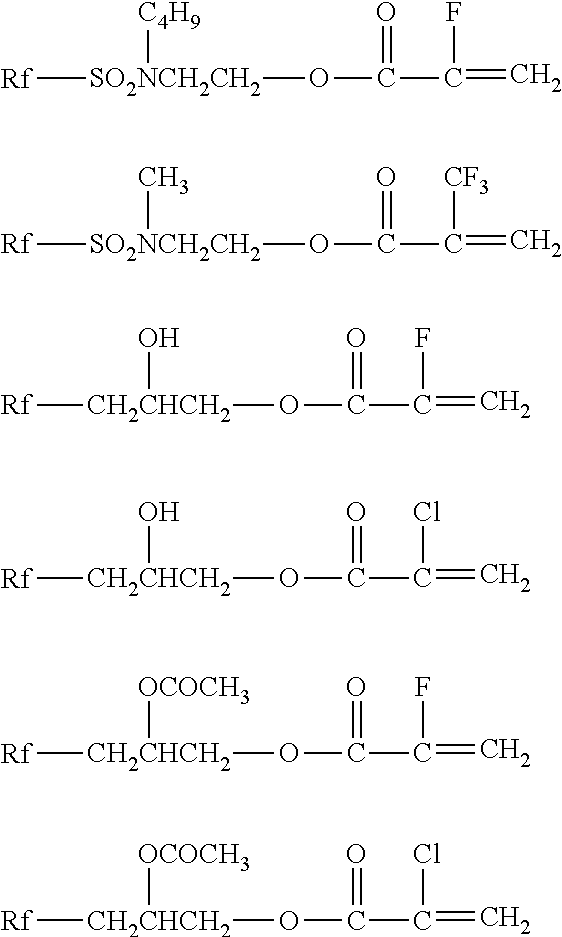Treatment comprising water- and oil-repellent agent
a technology of water- and oil-repellent agents, which is applied in the direction of liquid-repellent fibres, weaving, transportation and packaging, etc., can solve the problem of inability to obtain excellent water- and oil-repellency
- Summary
- Abstract
- Description
- Claims
- Application Information
AI Technical Summary
Benefits of technology
Problems solved by technology
Method used
Image
Examples
example 1
[0100]The fluorine-containing acrylate-based water- and oil-repellent agent (0.13 g) prepared in Preparative Example 1, a 1 wt % aqueous solution of methyl cellulose (Methyl cellulose SM-15, manufactured by Shin-Etsu Chemical Co., Ltd.) (0.5 g) and water (99.73 g) were mixed to prepare a mixture liquid and a 10% aqueous solution of sulfamic acid was added so that the mixture had pH of at most 2 to give a treatment liquid.
[0101]A carpet which was washed with water and dehydrated to WPU of 25% (WPU: wet pick up; when 100 g of the carpet absorbs 25 g of a liquid, WPU is 25%) was immersed in the above-mentioned treatment liquid for 30 seconds so that WPU was 250%. Then, an atmospheric pressure steam treatment (temperature: 100° C. to 107° C.) was conducted for 60 seconds under the state that a pile surface was upward. The carpet was lightly rinsed with 2 L of water and then centrifugal dehydration was conducted to give a WPU amount of 25%. Finally, the carpet was thermally treated at 11...
example 2
[0103]The carpet was treated in the same manner as in Example 1 except that the amount of the fluorine-containing acrylate-based water- and oil-repellent agent prepared in Preparative Example 1 was changed to 0.13 g, and 0.5 g of a 1% aqueous solution of hydroxypropyl methyl cellulose (Hydroxypropyl methyl cellulose 60SH-03, manufactured by Shin-Etsu Chemical Co., Ltd.) was used instead of methyl cellulose.
[0104]The resultant carpets were subjected to a fluorine adhesion rate measurement, a water-repellency test and an oil-repellency test. The results are shown in Tables 1, 2 and 3.
example 3
[0105]The carpet was treated in the same manner as in Example 1 except that the amount of the fluorine-containing acrylate-based water- and oil-repellent agent prepared in Preparative Example 1 was changed to 0.13 g, and 0.5 g of a 1 wt % aqueous solution of hydroxyethyl methyl cellulose (Hydroxyethyl methyl cellulose SEB-04T, manufactured by Shin-Etsu Chemical Co., Ltd.) was used instead of methyl cellulose.
[0106]The resultant carpets were subjected to a fluorine adhesion rate measurement, a water-repellency test and an oil-repellency test. The results are shown in Tables 1, 2 and 3.
PUM
| Property | Measurement | Unit |
|---|---|---|
| temperature | aaaaa | aaaaa |
| carbon number | aaaaa | aaaaa |
| temperature | aaaaa | aaaaa |
Abstract
Description
Claims
Application Information
 Login to View More
Login to View More - R&D
- Intellectual Property
- Life Sciences
- Materials
- Tech Scout
- Unparalleled Data Quality
- Higher Quality Content
- 60% Fewer Hallucinations
Browse by: Latest US Patents, China's latest patents, Technical Efficacy Thesaurus, Application Domain, Technology Topic, Popular Technical Reports.
© 2025 PatSnap. All rights reserved.Legal|Privacy policy|Modern Slavery Act Transparency Statement|Sitemap|About US| Contact US: help@patsnap.com



